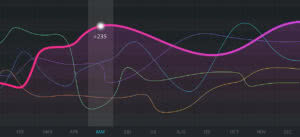Email is a direct line to potential attendees, making it one of the most powerful tools in your event promotion arsenal.
In fact, it was voted by far the most effective marketing channel for events, for the third year in a row, in our annual Pulse Report.
Which means the better you get at email marketing, the more revenue you’ll make.
So when should you be sending your event marketing emails — and how often — in order the maximise their effectiveness?
After all, if you send too many emails, you risk frustrating your recipients, tanking your open rates, or increasing unsubscribes. Send too few, and you risk reducing engagement with your campaigns or leaving money on the table.
In the first-ever Event Email Benchmarking Report, you’ll learn best practices for your email sends — and discover how other organisers’ emails are performing. Based on survey responses from over 340 event organisers across the U.S. and U.K., the data represents a wide range of event types and sizes.
Here are just some of the insights that the report revealed about email frequency and the best day to send:
Email Frequency
If you’ve ever rolled your eyes and hit “unsubscribe” after seeing yet another email from a certain company in your inbox, then you know how frequency can affect email performance.
So how does your email frequency stack up to the competition? Check out how frequently other organisers are sending emails:
As you can see, organisers in both the U.S. and U.K. are sending less than two emails per week.
Here are a few email frequency best practices:
- Have a regular send schedule. If you send your emails at the same day and time each week, there’s less of a chance you’ll surprise recipients and spark negative reactions. Communicate your send frequency early so recipients know how often to expect emails from you. For example specify it in during your email opt-in process (e.g. “Sign up for regular updates about X,Y,Z, hand crafted and digitally delivered direct to your inbox every Tuesday at 9am.”)
- Perform email frequency testing. Set up an email frequency test where you try out different frequencies (for example, weekly versus biweekly) and carefully measure your metrics. Over time, you should be able to see patterns in which frequencies are performing better.
- Offer customised email frequency. Provide an option in both your opt-in flow and unsubscribe page for readers to indicate how often they’d like to receive emails. You can also send a note to unengaged recipients asking what their preferences are — so you can adapt your frequency before they unsubscribe.
Day of the Week
If you know the best day of the week to send emails to your audience, you can dramatically improve your open rates. The day of the week that works best will likely vary a little depending on your audience. For example, if you’re organising a professional event, your business-focused content may perform better on the weekdays. If you’re a music venue promoter sending out last-minute updates on shows, the end of the week or even the weekend might be better.
But that doesn’t mean that you can’t learn from what other organisers are doing. So what did respondents say was the best day of the week to send event emails?Tuesday is the most popular day for U.K. organisers to send email, while U.S. organisers prefer Wednesday sends. Nearly a fifth of organisers worldwide send email on the weekend.
With such diverse responses across the industry, how can you find out which day of the week is best for your audience?
- Try a Tuesday send. Multiple studies have shown Tuesday to be the best day to send emails. It may not be the case for your audience, but it’s a good place to start. If you send two emails a week, the same studies argue that Thursday is the best day to send your second message.
- Test, test, and test some more. Send emails at certain days and times and carefully measure your metrics to see what performs best. This is the only surefire way to know what day is best for your specific audience.
What kind of metrics should you consider?
Try looking at open rates, click through rates, open to click through rates, unsubscribes and of course, ticket sales.
And if you’re not sure what good, bad of indifferent looks like for all of those key metrics (or even how to find them), and would like expert advice on how to improve them, it’s time to check out The Event Email Benchmarking Report.





